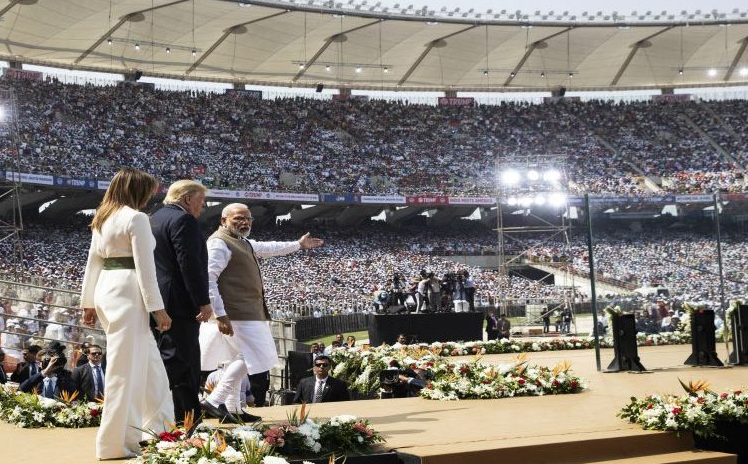An Irrelevant, Sad Stade of Existence Beckons Cricket | Outside Edge

The BCCI and its state units have infrastructure which could be used for Covid-19 relief measures — from the Wankhede to Eden Gardens and the new Motera stadium, the largest cricket venue in the world where the Donald Trump-Narendra Modi show was staged.
Editorial meetings during lockdown are intriguing affairs. The Newsclick sports team has been, let us say, quite inventive with them, joyriding almost all the video conferencing apps out there. We have used and discarded most of them too, the fault being not of the apps but that of the end users. Though video conferencing is not new in newsrooms — it still feels surreal to talk about work staring into a screen. Sport, after all, is not used to distancing protocols and we have been spoilt to the hilt by that. Or maybe, the real reason is we are a team of old grumps, happily ignoring solid evidence that the surreal and virtual have become the new reality.
So, one early afternoon the past week, while fighting the overwhelming sense of disillusionment from another video chat app and its virtuality, the talk moved onto the surreal, surrounding the starved existence of sport at the moment.
“How the mighty have fallen,” I had wondered out loud, inferring the crisis caused mainly by the spectacle-inclined industry organised sport has become. Parallely, sport is struggling to make itself relevant and efforts are being made by many — from football clubs in Europe, to individual athletes who are keen to do what they feel is right, trying to give back to society in a more concrete manner than rhetorical monetary donations or campaigns from behind the sanitized, quantified world of social media.
But there is a third track, parallel still to that parallel world: Indian cricket, which is still in denial. The IPL-brained thinktank can't seem to look beyond the Indian Premier League even as lockdown gets extended beyond its rescheduled starting date of April 15.
With curfew — in various forms — confirmed until the end of this month, the Board of Control for Cricket in India (BCCI) remains on the prowl, looking for open windows amidst locked ones. The futility of that effort is disturbing. But what's more worrying is the self-centred ways of the cricket establishment. Of course, the Board might feel entitled in the same way the privileged middle and upper class city dwellers felt after clanging their plates or lighting candles, 'contributing' to the cause against Covid-19. The BCCI has already donated Rs. 51 crore to the PM Cares fund. That absolves them of all selfishness, and frees them to pursue a 12-year-old Twenty20 league devoid of any lineage, legacy or history.
Legacy, in fact, was one of the main points we stressed upon in our edit chat that day.
We were wondering how stadiums would look and feel now — sans the fans, superstars or the action. We were mulling a photo essay of sorts, showcasing the eerie state of being stadiums across India are in right now. Surreal, no doubt!
We left it at that though for we would end up capturing nothing new. Indian stadiums are always surreal in existence. We were talking about facilities such as the Indira Gandhi Indoor Stadium complex in New Delhi which houses multiple venues — a velodrome, wrestling hall, boxing hall, a basketball stadium, a weightlifting hall and a gymnastics venue. Whenever we visited the complex, we were greeted with a stillness, an eerie silence louder than whatever crowd noise reverberated across the cavernous glass and concrete enclosures.
Read More | Playing Patience on an Island: Story of Andaman and Nicobar’s Elite, Yet Poor, Cyclists
It seems Indian stadiums were built for a perpetual lockdown. I remember a national team cyclist once complaining about him and his teammates getting booted out of the velodrome because an official figured that continuous riding on the surface could damage the flooring. As funny as it sounds, it is the sad reality of Indian sport projects — specifically stadiums — where the legacy of the facility hardly goes or grows beyond the immediate mega event it was built for.
Cricket, in this matter, is an exception. Stadiums see action round the year, though, their existence revolves around a sickening level of self-centredness. At least that's what one could gather from the way the BCCI, or its state units have been reluctant to pledge their huge facilities to the health authorities or governing bodies of respective cities. The Hyderabad Cricket Association is an exception here, having readily offered to hand over use of the Rajiv Gandhi Stadium to the government as a quarantine facility for Covid-19 patients.
What about the other famed venues of Indian cricket? Post lockdown, all of them would be in disuse, tasting silence and irrelevance their less-privileged cousins meant for other sports suffer. For the record, the Sports Authority of India (SAI) has already handed over many of its facilities across the country, including the Jawaharlal Nehru Stadium in Delhi for use in Covid-19 emergencies. The BCCI could take inspiration, or better still, take a cue from the keepers of the spirit of the game. The Marylebone Cricket Club (MCC) has handed over the keys to the most hallowed and storied venue in cricket, the Lord's, to the NHS in the UK.
The BCCI could not, of course. After all, they are still on the lookout to pounce on a chance to stage the IPL, and handing over its game venues for treatment of Covid-19 patients would put that in jeopardy. The latest reports suggest that the BCCI is hoping for an easing of curfew rules and is keen to stage matches behind closed doors. If that doesn't happen, they are hoping the ICC World T20 scheduled in Australia later in the year, would get cancelled or postponed. The Board hopes it could use that window to host the IPL. Whatever be the case, the plan can only be executed if they have their venues in their hands and not with state health departments.
Buildings, the public ones, are erected to serve specific purposes. Meeting those, and other causes for the larger good of the society is what makes public spaces relevant and historic. The London tube stations come to mind now, which acted as bomb shelters for the citizens during the German Blitzkrieg. The old Arsenal Stadium was transformed into an Air Raid Precaution stronghold. The halls of Old Trafford were used to treat injured soldiers. They all stand tall now. How tall does Wankhede, the Eden Gardens, or the new Motera stadium (the largest cricket venue in the world where the Donald Trump-Narendra Modi show was staged) stand? Apparently not quite as lofty. And with each BCCI misstep, their walls get lowered, stature gets diminished, legacy diluted and history questioned. It will only be a matter of time before every batsmen in the middle would fancy hitting the ball out of them — metaphorical sixers in a "small" venue.
Get the latest reports & analysis with people's perspective on Protests, movements & deep analytical videos, discussions of the current affairs in your Telegram app. Subscribe to NewsClick's Telegram channel & get Real-Time updates on stories, as they get published on our website.
























